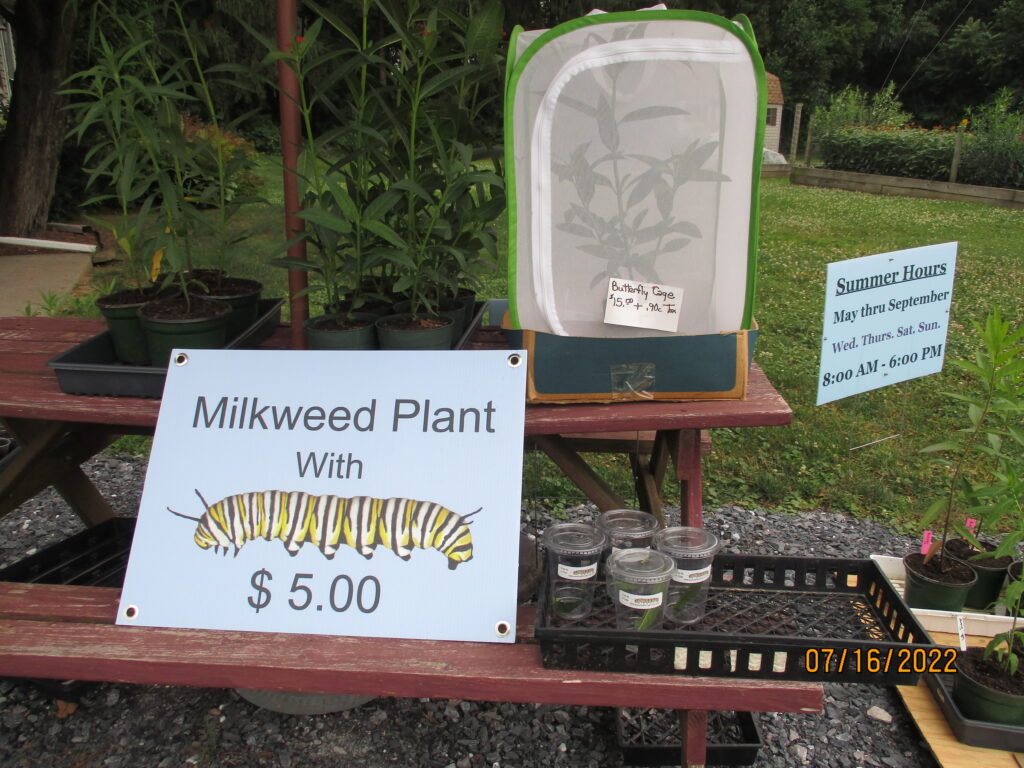Here’s the complete Milkweed species list being grown for seeds in 2023. Seeds will be available this Fall for many of them.
- A. amplexicaulis. Common name: Clasping M.
- A. angustifolia. Common name: Arizona M.
- A. arenaria: Common name: Western Sand M.
- A. asperula. Common name: Antelope Horn.
A. cordifolia. Common name: Heartleaf M.Unable to get them to thrive. Re-started 3 years in a row.- A. curassavica. Common name: Tropical M., Bloodflower M. in Silky Red Tropical and Silky Gold Tropical
- A. eriocarpa. Common name: Indian M., Kotolo M. or Wooly Pod M.
- A. erosa. Common name: Desert M.
- A. exaltata. Common name: Poke M.
- A. hallii. Common name: Hall’s M.
- A. hirtella. Common name: Tall Green M.
- A incarnata. Common name: Swamp M. in White and Pink.
A lanceolata. Common name: FewflowerM. ** Not true to species- A. latifolia. Common name: Broadleaf M.
- A. linaria. Common name: Pine Leaf M. , Pineneedle Leaf M.
- A. fascicularis Common name: Narrowleaf M. or Mexican Whorled M.
- A. nivea. Common name: Caribbean M.
- A. oenotheroides. Common names: Zizotes M. or Longhorn M.
- A. ovalifolia. Common name: Oval leaf M.
- A. perennis. Common name: Aquatic M. or Swamp M.
- A. purpurascens. Common name: Purple M.
- A. speciosa. Common name: Showy M.
- A. subulata. Common name: Rush M. or Desert M.
- A. subverticillata. Common name: Horsetail M.
- A. sullivantii. Common name: Prairie M. or Sullivant’s M.
- A. syriaca. Common name: Common M.
- A. tuberosa. Common name: Butterfly Weed M. in Orange or Yellow
- A. variegata. Common name: Redring M.
- A. viridiflora. Common name: Green Comet M.
- A. viridis . Common names: Green Antelopehorn M. or Green Spider M.
- A. verticillata. Common name: Whorled M.
- Calotropis gigantea. Common name: Giant M. or Crown Flower M. in Purple or White
- Calotropis. procera. Common name: Giant M.
- Cynanchum laeve. Common name: Honeyvine M.
- Gomphocarups cancellatus. Common name: Cape Milkweed ** New this year
- Gomphocarpus fruticosus. Common name: Swan Milkweed
- Gomphocarpus physocarpus. Common name: Hairy Balls or Balloon M.
- Matelea gonocarpus or Gonolobus suberosus. Common name: Angel Pod M. ** New this year
- Tweedia caerulea. (old name Oxypetalum caerulea) Common name: Blue Tweedia M. or Blue M.
- Tweedia solanoides. Common name: Pink Tweedia M.
Live Plants for sale available May – August (Local pickup only at the Milkweed Market)
$2 each. 3-4 weeks old.

- A. incarnata Pink. Pink Swamp M.
- A. incarnata White. White Swamp M.
- A. syriaca. Common M.
- A. tuberosa. Butterfly Weed M. Orange and Yellow
- A. curassavica. Tropical M. Silky Red and Silky Gold
- Nectar flowers like Coneflower, Zinnia and Mexican Sunflowers while supplies last
Caterpillars show up later in July

Mature potted Tropical Milkweed plant with a free Monarch caterpillar will be available later in July. These will fit inside the mesh Monarch *cages. $5 each *** Start time will depend on when the Monarchs show up and start laying eggs. Here in south central PA it’s usually middle of July before caterpillars are seen in any quantity. A top banner on the website will give updated info or reach out and contact me. *Some cages will be available for sale $20.00. Local pick up.
Hi, This note is a question to Robert but anyone feel free to answer. I’ve just began growing milkweed and have lots of questions.I grew the “ hairy balls” last year and this year it went from 2 plants to 15. When you say you pick off the leaves ( not balloon-like balls) for feeding the cats, is there any reason you chose the 4 you mentioned. Are there any observations that the monarch cats like these better? Btw, I never saw a Monarch last year on the balloon type milkweed. We’ll see this year. The plants are 6 feet and their beginning flowers will be balls in a while. I’m in Dallas, Tx where we have unusually high temperatures in July- August now.
Hi Susan, From my experience with collecting eggs and finding caterpillars, the 4 that Robert mentioned seem to always have the most activity because of their soft leaves. That doesn’t mean that you couldn’t feed your cats any other milkweed but those are all fast growing and continue to pump out lots of leaves all season. Hope you have a Monarch filled summer 🙂 Cindy
Thank you for sharing your knowledge!
You are very welcome. You can contact me directly if you have any other questions. cindyleonard317@gmail.com Have a great summer. Cindy
I’m glad to see someone else growing Honeyvine (Cynanchum laeve). I planted some 5 or 6 years ago from seeds I bought off eBay, and it comes back every year in southern Minnesota even though this is supposed to be too far north. It doesn’t come up until June and I always wonder if it survived the winter. It seldom makes viable seeds here; the season is too short — that’s probably a good thing because it could really be invasive. In case you haven’t found out yet, it spreads aggressively by underground rhizomes and you’ll have little shoots popping up 20 to 30 feet from your mother plant. It’s worse than A. syriaca in that regard. The monarchs love laying eggs on the small plants coming up in the lawn, so check them before you mow.
I don’t find many eggs on the mature vines (perhaps because there are so many leaves it’s hard to check them) but I find a few, and the leaves are *great* fodder for caterpillars I pick off the swamp, tropical, common, and “hairy balls” MW.
Hi Robert,
I do love my Honeyvine and you are right it has a very long seed maturing need. It only just started blooming this week (end of July)! Last year I finally brought in the last pods in Nov.
I have mine contained and collect all the seeds for sale but I can see that it could be a fast spreader via rhizomes so I don’t understand why there isn’t any around. It provides fast food and a lot of it and then dies back over the winter, well at least it does here in PA.
I don’t have the time to check for eggs on the Honeyvine either and just stick with looking for them on the same species that you’ve found success.
Always good to hear from a fellow “Milkweeder”. Have a great Monarch summer, Cindy